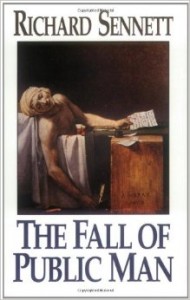 My previous post was oddly prescient. As I’ve progressed further into the book, I’ve stopped today at a section which discusses the relationship between text and performance.
My previous post was oddly prescient. As I’ve progressed further into the book, I’ve stopped today at a section which discusses the relationship between text and performance.
To get there, Sennett has passed through fascinating discussions of fashion and done a comparative section about the emergence of “personality” in the 19th century, as opposed to “nature” in the 18th. This will take some time to examine in detail. There’s a lot of foregrounding to the changes in texts and performances across the the centuries to be established.
The bare bones of it start with Diderot’s “paradox of acting.” The relationship between the theater and the theater of the street are a lot closer than I’d really thought about before encountering this book. Sennett proposes that as cities grew, urban life forced a more restrained approach to the emotions. One had to do his crying/celebrating/emoting in private to a greater degree so as to avoid being vulnerable to the increasingly wide-ranging population that surrounded them. Popular theater began parallel development. Theatrical performance diverged from religious spectacle and ritual performances in important ways.
Most 16th and 17th Century French theories of acting correlated how an actor performed with the contents of what he or she performed. The truth of the lines spoken had some relationship to how well the actor could speak. Thus it was possible to subsume the idea of acting under the rubric of rhetoric, and to talk of rhetoric in relation to morals and religion. In this formula the priest became the greatest possible rhetorician because the lines he spoke were absolute truth. No good Christian would dream, of course, of directly comparing priest and actor, but the reason lay precisely in the fact that the priest’s rhetoric was innately superior to anything possible on the stage because he was speaking divine truth.
Diderot broke this connection between acting, rhetoric and the substance of the text. In his Paradox he created a theory of drama divorced from ritual: he was the first to conceive of performing as an art form in and of itself, without what was to be performed. The “signs” of the performance were not the “signs” of the text. I put this less clearly than Diderot. He writes:
If an actor were full, really full, of feeling, how could he play the same part twice running with the same spirit and success? Full of fire at the first performance, he would be worn out and cold as marble by the third. (110-111)
The complexity of Sennett’s argument is higher than it might seem at first glance. An actor’s emotions are not real human emotions- how could they be with any degree of repeatability? Underneath this though, is the contention that the emotions contained in the text are not the same as the emotions conveyed by the performance. Though Sennett doesn’t spend a great deal of time talking about what was happening in rhetoric around this time, I did a bit of a refresher on the side that I might discuss at greater length later.
The gist of it is this: the elocutionary movement in rhetoric had two competing factions. On one side, emotions were treated like a public, standardised language that could be simplified (to reach the broadest possible audience). Like all languages, this public display of emotion was a bit arbitrary, and separated (and cartoonish) when compared to the personal experience of emotion. A second faction that emotion (as a communicated language) needed to be more like the private version, only restrained and polite. Elocutionary manuals were frequently written by actors, as a matter of fact. They didn’t agree on the proper approach either. Rhetorical scholarship in this area isn’t particularly helpful, since most scholars tend to collapse this distinction as meaningless. I can see several reasons for this, but I don’t want to stray too far from my short point today.
Returning to Diderot’s Paradox, Sennett continues to explain the distinction between emotions and enacted emotions is that “the tears of real life are immediate and direct, while the tears brought on by art must be produced consciously, by degrees” … “At best, in the world where sympathy and natural feeling govern, if there is an exact representation of an emotion it can happen only once” (111, 112). I think that the disjunction in locating the emotion “in the text” is arises when you think of the emotion as manifest primarily in the “sympathy and natural feeling” of an audience; in reading, yes, you might locate an emotion in the text. But in a performance, the emotion exists as conveyed by a physical manifestation of the text (the actor), which must take precedence.
Diderot contended that the actor could not feel the emotion of the text and be a successful actor. Other critics did not agree, Sennett characterizes the debate as one “the argument between sentiment and calculation” (114). Actors, it was thought, could as rational actors calculate the correct means of conveying the emotion as felt. The emotions of theater were debated as if they were a secular “truth” to be conveyed in a genuine (calculated to be genuine, at least) way or as a generic display of more easily communicated “sentiment,” in short, rational sense vs. sensibility.
The core of this argument though, was accepted by both sides: the performance was a thing separate (and to 20th century critical eyes, inferior) to the text. Who decides what emotion is expresssed, the actor or the playwright? Sennett later explores the attempts to make performances more answerable to texts in the 19th century. He uses music as a gateway. Is a musical score a prompt or a bible?
There’s much more to think through from here.